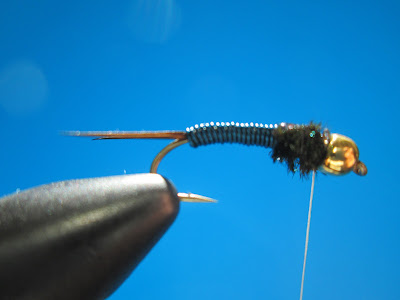The Blood Dot is arguably the most popular egg pattern for Great Lakes steelhead. Invented by PA steelhead fisherman Jeff Blood, the Blood Dot is a highly realistic imitation of a single steelhead egg. The fly is not named because its characteristic dot is supposed to imitate blood, but because it "Blood's" dot. This is the original Blood Dot pattern just as Jeff ties them. This fly has become so popular that almost every fly pattern tied out of Glo-Bug yarn with a dot is called a blood dot. Most
are not blood dots, however they are tied out of heavily compacted yarn tied in a round ball. The tightly packed yarn is not a good imitation of the translucent steelhead egg.
Hook: MFC no. 7045 size 10-18
Thread: UTC 6/0, color to match dot or body color.
Body: Glo-Bug Yarn, tied in sucker spawn style. Usually a egg color.
Dot: Glo-Bug Yarn, usually a bright color
STEP 1: With a Montana Fly Company no. 7045 size 10, 12, 14, or 16 in your vise, attach the thread behind the eye with a jam knot and wrap back to just in front of the barb. Don't go back too far or you will distort the proportions of the entire fly.
STEP 2: Separate a strand of Glo-Bug yarn into strands the diameter of the hook gap. For a size 12 hook, you usually get 4-5 strands from the main piece. Sparseness is the key to this pattern. Less material means more translucency and more fish. Tie the strand of Glo-Bug yarn in at the tie in point, and make enough thread wraps so the hook shank is all the color of the thread.
STEP 3: Advance your thread 3 wraps and form the first egg loop by bringing the yarn forward and tieing down with a pinch wrap. This loop should be small, about half the size of the hook gap.
STEP 4: Advance your thread another 3 wraps, your thread should be 2/3 the way up the shank from the tie in point now. Form a second loop that is slightly larger than the first. Make sure to make this loop messy, push it back over the first loop.
STEP 5: Take another piece of glo bug yarn (a bright color such as orange or chartreuse) and split it into strips that are 1/2 the size of the ones you used earlier. Less is more with this fly, you need to experiment to see how much material you need. Take the yolk/dot material and tie it in in front of the second loop. Pull both ends up and make a couple of more wraps in front of the yarn.
STEP 6: Make the last loop directly in front of the dot. This loop should be the same size to slightly smaller in size than the second loop. Push the loop back over the dot. Cut off the excess material tag.
STEP 7: Pull both the ends of the dot material up at the same time and cut the material off at a angle. Whip finish and cut off the thread.
 |
| The Finished Fly |
I prefer to tie Blood Dots in sizes 12-16 for low water steelhead. I do sometimes use a size 10 orange/red Blood Dot for dirty water, I prefer to use Estaz Spawn, Crystal Spawn, or Otter's Egg 3x6mm Cluster's steelhead in off-color water. Steelhead egg are usually a tannish color with a orange or pink tint (I call this egg color). The embryo inside the egg is usually orange. The most effective colors for steelhead are egg/orange, egg/pink, egg/chartreuse, egg/cerise, and egg/blue. For water that's a bit off-color (or a green tint) I like to use a blood dot with a pink, orange, chartreuse, or blue body with a red dot. Another option for tieing is to use Glo-Bug Bling yarn which has pieces of flash embedded in it.
 |
| Egg/Orange |
 |
| Egg/Pink |
 |
| Egg/Chartreuse |
 |
| Egg/Cerise |
Jeff Blood ties the Blood Dot


























































